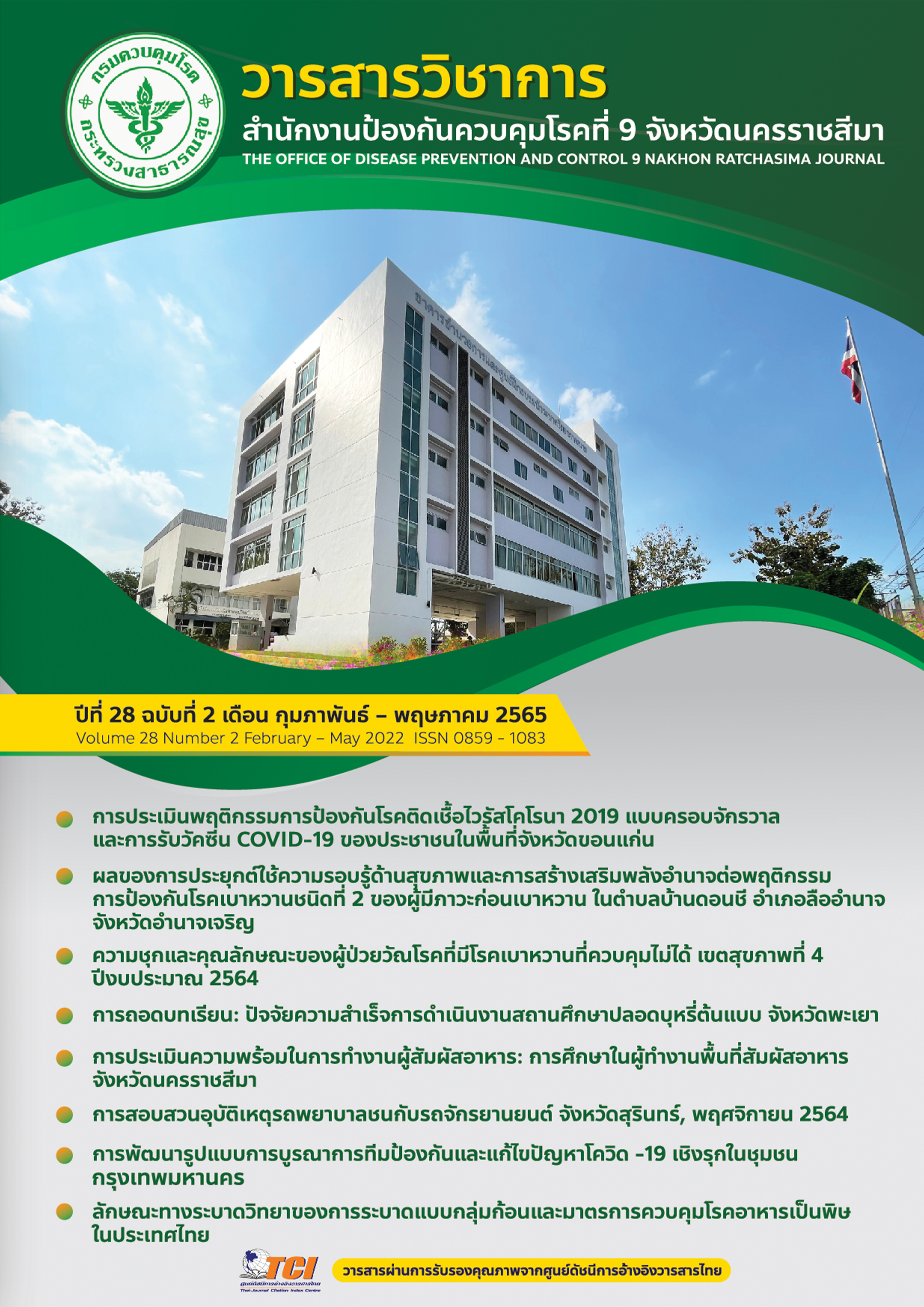An Ambulance Accident with Serious outcomes Investigation, Surin, November 2021
Keywords:
accident, ambulance, motorcycle, deathAbstract
Background: An ambulance accident with proved fatal victim was notified to The Office of Disease Prevention and Control 9th Nakhon Ratchasima (ODPC9) on 19th November 2020 from Surin Provincial Public Health officers. This situation happened in Surin province. Joint Investigation Team (JIT) and Road Traffic Injury Team (RTI) of ODPC9 conducted the investigation on 24th November 2020 to evaluate etiology and epidemiology, and provided suitable recommendations for future accident prevention and control to locals. Method: Epidemiologic descriptive study; the information about ambulance accident scenario, drivers’ and passengers’ behaviors were accumulated as medical records of the fatal victim to identify causes of death. Medical staff, drivers, police and witnesses were interviewed. The environment at scene and post-cash vehicles were studied. Haddon Matrix and Swiss Cheese Model were used as analytic methods to evaluate the factors of this accident. Result: Five people directly involved in the accident; 3 passengers and a driver in the ambulance, and a male driver on motorcycle who got injured and died eventually. The fatal one was mentioned to have various risk behaviors that influenced in this accident; he had an alcoholism and abnormal eyes vision, and was often neglected wearing safety equipment. Therefore, he experienced nearly car crashed several times. The environment at scene was unsafe as there was a destructive street isle to cross the road or make a U-turn, made by local people illegally, which became the spot of car accidents many times. Conclusion: There were two main causes from data analysis of this ambulance accident. Firstly, the deceased himself, both his inappropriately physical condition and behaviors could lead to this tragedy. Secondly, an unsafe environment; the illegal U-turn was built. Therefore, the number of accidents here were reported as drivers who used the main route were not aware of any unexpected vehicles crossing through street isle. To tackle this, JIT and RTI teams performed short-term management immediately by bringing plastic barriers to cover this illegal route and cooperating with Department of Highways for permanent solutions.
References
Daniel J. Barnett, Ran D. Balicer, David Blodgett, Ayanna L. Fews, Cindy L. Parker, and Jonathan M. Links. The Application of the Haddon Matrix to Public Health Readiness and Response Planning. Environmental Health Perspectives 2005; 113(5): 561-6.
James Reason. Human error: models and management. BMJ 2000; 230: 768-0.
Dinesh M., Geetam T., Meleckidzedeck K. and Fredrick Muyia N. Road traffic injury prevention training manual, Geneva: World Health Organization; 2006.
จิรพงษ์ ศุภเสาวภาคย์, เกษมสุข โยธาสมุทร และศุภฤกษ์ สัทธาพงศ์. กระบวนการคัดกรอง. ใน: รัฐพงษ์ บุรีวงษ์, บรรณาธิการ. MOPH ED. Triage. พิมพ์ครั้งที่ 1. กรุงเทพฯ: สำนักวิชาการแพทย์ กรมการแพทย์ กระทรวงสาธารณสุข; 2561: 1-4.

Downloads
Published
How to Cite
Issue
Section
License
Copyright (c) 2022 The office of disease prevention and control 9th Nakhon Ratchasima

This work is licensed under a Creative Commons Attribution-NonCommercial-NoDerivatives 4.0 International License.
บทความที่ลงพิมพ์ในวารสารวิชาการสำนักงานป้องกันควบคุมโรคที่ 9 จังหวัดนครราชสีมา ถือว่าเป็น
ลิขสิทธิ์ สำนักงานป้องกันควบคุมโรคที่ 9 จังหวัดนครราชสีมา



